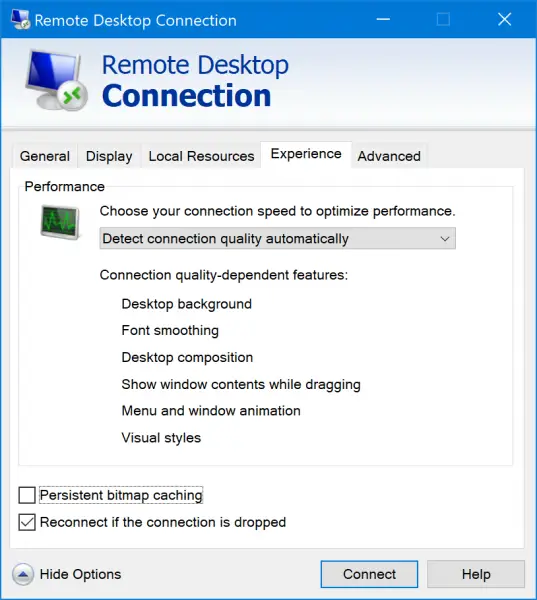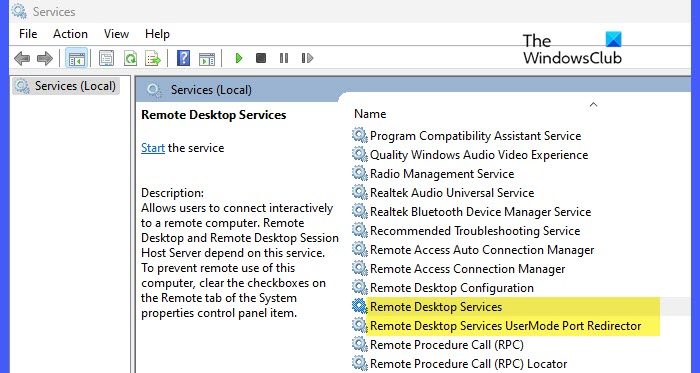According to some reports, using RDP or Remote Desktop Protocol on recent versions of Windows 11/10 results in a black screen. One encounters this issue when using the Remote Desktop Connection feature on Windows 11/10. The real causes of this black screen are either the display drivers or some misconfiguration with the Remote Desktop Connection utility.

Windows 11/10 RDP Black Screen
Typically, Windows 11/10 Remote Desktop throws up a Black Screen and then disconnects. The following working methods will help you resolve the Windows RDP black screen issue:
- Disable Persistent bitmap caching
- Update the Display driver
- Restart the Remote Desktop Services
Let us see this in detail.
1] Disable Persistent bitmap caching
Persistent bitmap caching is a feature in Remote Desktop that stores frequently used images and graphics on the client machine to reduce the amount of data that needs to be sent over the network, thereby improving performance and making the remote session appear faster and more responsive. However, if the cached bitmaps are not updated correctly, persistent bitmap caching can lead to outdated or corrupted display data, causing display issues, including the black screen problem.
To disable persistent bitmap caching, open the Remote Desktop Connection client.
Select the Show Options button to configure your Remote Desktop Connection. Go to the Experience tab.

Uncheck the option for Persistent bitmap caching.
Disabling persistent bitmap caching forces the Remote Desktop session to retrieve fresh image data directly from the host machine rather than relying on potentially outdated cached data. This can resolve issues related to display corruption or black screens.
You can now connect to the remote computer normally and your issue must be fixed now.
2] Update the Display driver
You need to update the Graphics Drivers. You will get the Driver download links here.
Go to the website of your manufacturer like NVIDIA, AMD or Intel. Open the section called Drivers and download the latest version of drivers from there.
After the download has been completed, just install the Display driver and reboot your computer.
This should fix the black screen issue with RDP.
3] Restart the Remote Desktop Services

Restarting the Remote Desktop Services on the host machine can resolve black screen issues.
Press Win + R to open the Run dialog box. Type services.msc and press Enter.
Locate and restart the following services in the Services window:
- Remote Desktop Services
- Remote Desktop Services UserMode Port Redirector
Exit Services.msc and try connecting again.
I hope this helps.
How do I fix a blackout on my desktop?
A black screen on a Windows PC can appear due to several reasons, ranging from software glitches to hardware issues. To troubleshoot a black screen, start by checking all cables and connections to ensure they are secure and not damaged. This includes the power cable, monitor cable, and any adapter connections. Next, boot into Safe Mode. If the screen works in Safe Mode, it is likely a driver, application, or settings issue. If the blackout started after a recent update or software installation, uninstall the update or software in Safe Mode. Also, reset display settings to default.
Why is my server showing a black screen?
If you encounter a black screen while accessing a server via Remote Desktop, the remote desktop session might be set to an unsupported resolution or the server might be under heavy load, causing it to be unresponsive. Before connecting, go to the Remote Desktop client settings and adjust the display resolution to match the server’s capabilities. Try restarting the session to rule out the possibility of temporary glitches. Also ensure the Remote Desktop client on your local machine is up to date. Reinstall if necessary and test with a different user account to determine if the issue is related to a specific user profile.
Read Next: Taskbar not visible in Remote Desktop on Windows.
Leave a Reply